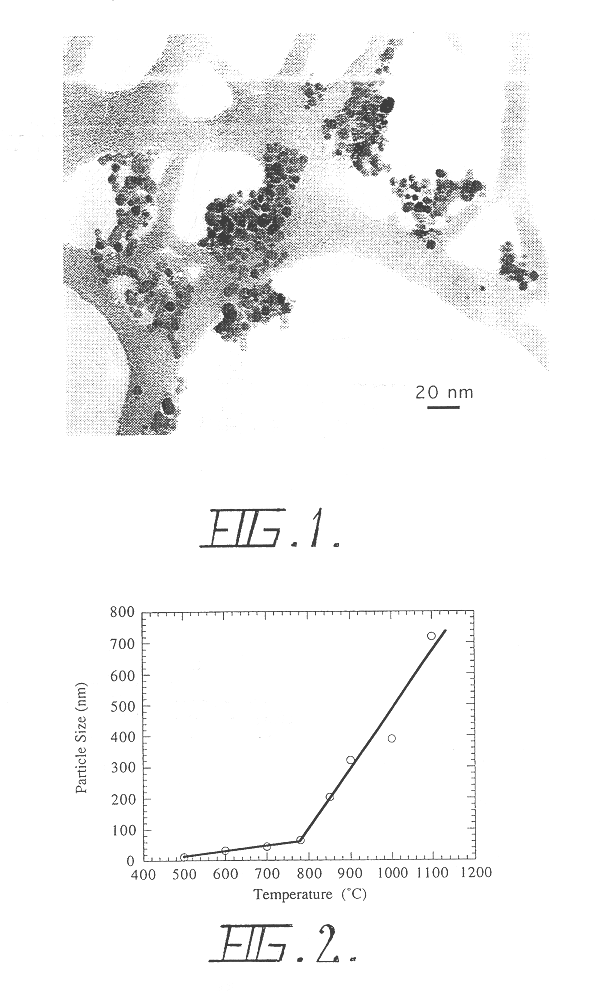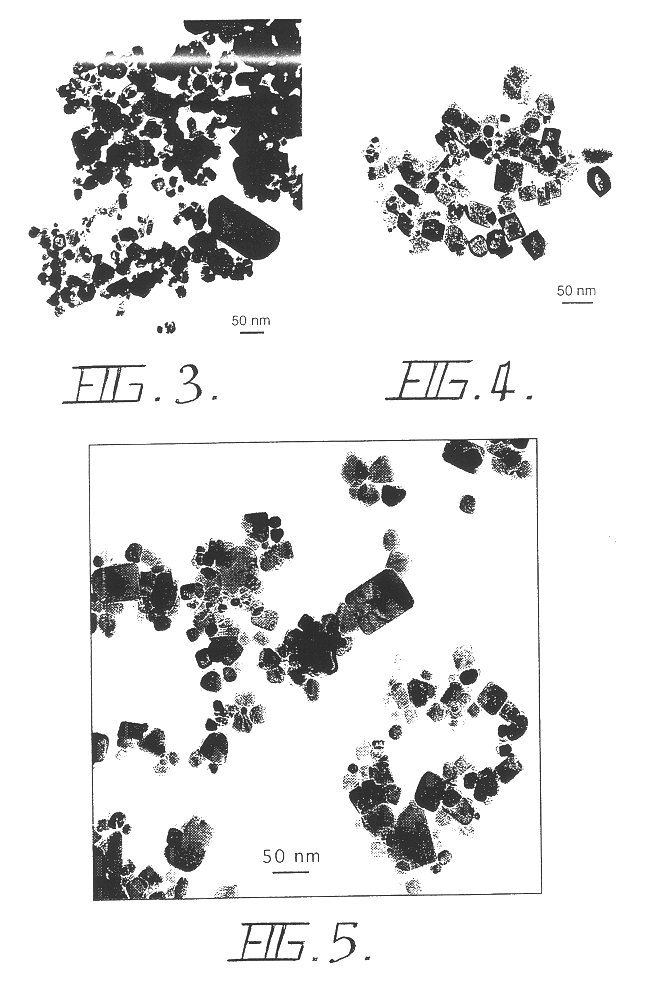Process for the production of ultrafine powders of metal oxides
a technology of metal oxides and ultrafine powders, which is applied in the direction of aluminium oxides/hydroxides, lanthanide oxides/hydroxides, magnesium compounds, etc., can solve the problems of high cost, low yield rate, and general non-application of chemical methods to the production of metallic powders
- Summary
- Abstract
- Description
- Claims
- Application Information
AI Technical Summary
Benefits of technology
Problems solved by technology
Method used
Image
Examples
example 2
SnO.sub.2 from SnCl.sub.2
The materials used were SnCl.sub.2 (>99%) and NaCl (99.5%). The starting mixture of SnCl.sub.2 and NaCl powders with a volume ratio of 1:10, and a total mass of 5 g, was loaded into a SPEX mixer / mill with 50 g of steel grinding media of 6.4 mm diameter, in an argon atmosphere. The ball to powder mass ratio was 10:1. Milling was carried out for three hours. After milling, the powder was annealed at 800.degree. C. in an air atmosphere for 30 minutes to oxidise the SnCl.sub.2. Removal of the NaCl diluent was carried out by washing the annealed powder with distilled water. The washed powder was dried in an oven at 60.degree. C. Separated, equiaxed nanoparticles of SnO.sub.2 were obtained. The particles were 20-200 nm in size and possessed many surface facets. FIG. 3 shows a transmission electron micrograph (TEM) of the SnO.sub.2 particles formed after heat treatment.
example 3
Al.sub.2 O.sub.3 from Al(OH).sub.3
The materials used were Al(OH).sub.3 (-100 mesh) and NaCl (>99.5%, .ltoreq.500 .mu.m) The starting mixture of Al(OH).sub.3 and NaCl powder containing 9 wt % Al(OH).sub.3, corresponding to 10 vol % Al(OH).sub.3, was loaded and sealed in a nitrogen atmosphere in a 7 liter attrition mill containing 25 kg grams of 6 mm diameter stainless steel grinding balls. The ball to powder charge mass ratio was 22.1. The milling time was 2 hours. After milling the powder was calcined in air at 850.degree. C. for 1 hour. Removal of the NaCl was carried out by washing the powder with deionised water using an ultrasonic bath and a centrifuge. The washed powder was dried by evaporation in air at 60.degree. C. X-ray diffraction measurements showed that gamma alumina was formed during the heat treatment by dehydration of the Al(OH).sub.3. The resulting Al.sub.2 O.sub.3 particle size determined from BET surface area measurements was 11 nm.
example 4
ZrO.sub.2 from ZrOCl.sub.2
The materials used were ZrOCl.sub.2.cndot.nH.sub.2 O and NaCl (>99.5%, <500 .mu.m). The as-received ZrOCl.sub.2.cndot.nH.sub.2 O was dried in a vacuum to remove the attached H.sub.2 O. The starting mixture of 10 grams of ZrOCl.sub.2 and 115 grams of NaCl powder, corresponding to 10 vol % ZrO.sub.2, was loaded and sealed in an argon atmosphere in a 1 liter attrition mill containing 2.5 kg grams of 2.5 mm diameter Zirconia grinding balls. Milling was carried out for one hour. After milling, the powder was calcined in air at 500.degree. C. for 1 hour to decompose the ZrOCl.sub.2 into ZrO.sub.2. Removal of the NaCl was carried out by washing the powder with deionised water using an ultrasonic bath and a centrifuge. The washed powder was dried by evaporation in air at 60.degree. C. X-ray diffraction measurements showed that tetragonal or cubic grains were formed during calcining. The resulting ZrO.sub.2 particle size determined from x-ray diffraction, transmissi...
PUM
| Property | Measurement | Unit |
|---|---|---|
| size | aaaaa | aaaaa |
| size | aaaaa | aaaaa |
| temperatures | aaaaa | aaaaa |
Abstract
Description
Claims
Application Information
 Login to View More
Login to View More - R&D
- Intellectual Property
- Life Sciences
- Materials
- Tech Scout
- Unparalleled Data Quality
- Higher Quality Content
- 60% Fewer Hallucinations
Browse by: Latest US Patents, China's latest patents, Technical Efficacy Thesaurus, Application Domain, Technology Topic, Popular Technical Reports.
© 2025 PatSnap. All rights reserved.Legal|Privacy policy|Modern Slavery Act Transparency Statement|Sitemap|About US| Contact US: help@patsnap.com


